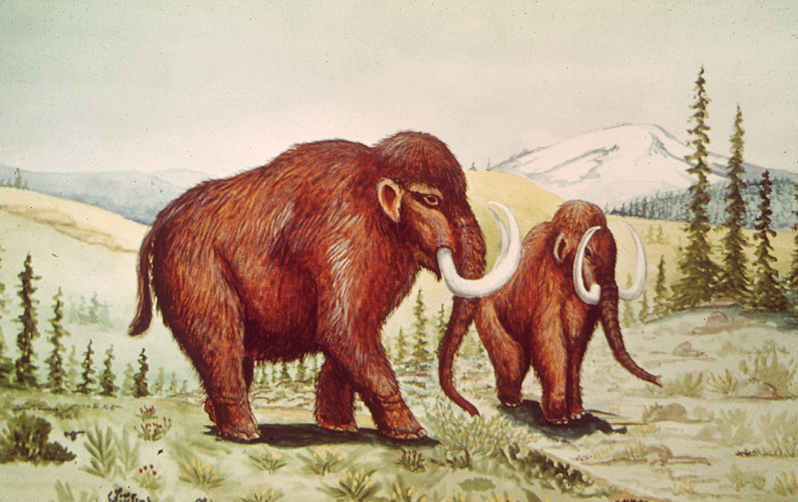Canadian Journal of Earth Sciences. 2 May 2024. https://doi.org/10.1139/cjes-2023-0102
Survival of mammoths (Mammuthus sp.) into the Late Pleistocene in Southwestern British Columbia (Vancouver Island), Canada.
Laura Termes, Grant Keddie, Richard Hebda, Pat Trask, Victoria Arbour, Camilla Speller, L. Paskulin, Chris Ramsey and Michael Richards.
Abstract
As part of a larger project identifying and directly radiocarbon dating Late Pleistocene megafaunal remains in British Columbia (B.C.), Canada we have confirmed the identity of many newly identified mammoth (Mammuthus sp.) specimens (n=32) from Vancouver Island in Southwestern B.C. We undertook radiocarbon dating on all specimens and were able to obtain dates (due to preservation) on 16 of these remains, including re-dating a previously dated mammoth using newer radiocarbon extraction methods. The mammoth dates span a wide range, from >47,500 to 18,000 radiocarbon years BP (uncalibrated). These later new dates support other lines of evidence for portions of Vancouver Island remaining unglaciated towards the end of Late Pleistocene.

Old painting of mammoths by unknown painter. Grant Keddie Collection.
Journal of Quaternary Science. Vol. 38. Issue 1, January 2023:8-20. https://doi.org/10.1002/jqs.3451
Dietary niche separation of three Late Pleistocene bear species from Vancouver Island, on the Pacific Northwest Coast of North America.
Cara Kubiak, Vaughan Grimes, Geert Van Biesen, Grant Keddie, Mike Buckley, Reba MacDonald, Michael P. Richards.
Abstract
Competition between taxa related to climate changes has been proposed as a possible factor in Pleistocene megafaunal extinctions, and here we present isotope evidence of the diets of three co-existing bear species [black bear (Ursus americanus), brown bear (Ursus arctos), and the now extinct short-faced bear (Arctodus simus)] from a locale in western North America dating to the Late (Terminal) Pleistocene (~14.5–11.7 ka). The three bear species were found at several sites on Vancouver Island, on the western coast of Canada. To examine the chronological overlap and niche partitioning between these species of bear, we used direct radiocarbon dating, stable isotope analysis and ZooMS proteomic identification methods. Here we present new radiocarbon evidence from Terminal Pleistocene U. americanus, U. arctos and A. simus from several sites on the island, along with both bulk collagen and compound-specific isotope data for these species. Radiocarbon dates confirm the chronological overlap of Arctodus and both Ursus species in the montane regions of the island at the end of the Pleistocene. Stable isotope data reveal niche differentiation between these species, with U. americanus occupying a distinctly lower trophic position than the other two taxa.
Journal of Quaternary Science 2016. 31(2):126-142. https://doi.org/10.1002/jqs.2849
Taxonomy, location of origin and health status of proboscideans from Western Canada investigated using stable isotope analysis.
Jessica Zoe Metcalfe, Fred John Longstaff, Christopher N. Jass, Grant D. Zazula, Grant Keddie.
Abstract
We investigated the application of stable isotope analysis of proboscidean remains (collagen in bone/dentin/cementum and structural carbonate in enamel bioapatite) for genus-level identification of isolated specimens, assessment of geographical origins, and testing for nutritional stress. Mammoths (Mammuthus sp.) tended to have higher δ15Ncol and lower δ13Ccol than mastodons (Mammut americanum), but differences were not significant in every location. Determining the genus of isolated specimens may be possible for locations and time periods with good isotopic baselines, but environmental changes can confound interpretations. For example, an Alberta proboscidean with a δ15Ncol of +1.4‰ (characteristic of mastodons) ultimately proved to be a mammoth. Its surprisingly low nitrogen isotope composition is attributable to the recently deglaciated environment it inhabited. We provided a baseline for isotopic assessment of geographical origins of isolated proboscideans in Western Canada. Bioapatite δ13Csc and δ18Osc can be used to distinguish specimens from Alberta, Klondike, Old Crow, Herschel Island and further south (e.g. Arizona, Great Lakes). Finally, we found that an Alberta mammoth with morphological evidence of nutritional stress experienced a change in diet, environment or physiology before death, but its isotopic compositions did not suggest a link to hypothesized starvation (catabolism of proteins or reliance on lipids).
Canada Biology Letters. 21:20250305.
Genomic and morphological analysis reveals long-term mammoth hybridization in British Columbia, Canada.
Authors:
Marianne Dehasque, Tom van der Valk, J. Camilo Chacón-Duque, Laura Termes, Petter Larsson, Hannah Moots, Florentine Tubbesing, Juliana Larsdotter, Gonzalo Oteo García, Kelsey Moreland, Hans van Essen, Victoria Arbour, Grant Keddie, Michael Richards, David Díez del Molino, Peter D. Heintzman, Adrian Lister and Love Dalén.
Abstract
Climate changes profoundly impact species distributions and can drastically alter dynamics between formerly isolated taxa. The evolution of mammoths within North America was characterized by repeated cycles of dispersal and putative gene flow between woolly and Columbian mammoths. However, as genome-wide studies on mammoths have predominantly focused on Siberia, the consequences of these North American range shifts remain unclear. Here, we generated genome-wide and morphological data for two Late Pleistocene mammoth molars from British Columbia, Canada (BC), and jointly analysed these with previously published data. Our genome-wide analysis (n = 16) revealed gene flow between woolly and Columbian mammoths that would have gone undiscovered based on morphological (n = 48) and mitochondrial analysis (n = 124) alone. Consistent with their hybrid nature, our analyses suggest that these two BC mammoths had elevated genomic diversity. Our results highlight the importance of combining data types to reconstruct past evolutionary events. These findings demonstrate how the geographical range expansion of woolly mammoths resulted in long-term hybridization with local Columbian mammoths and enhance our understanding of the genomic and morphological consequences of climate-mediated dispersal.
The image here shows the Mount Tolmie mammoth molar (EH94.003.002; old # 297). Based only on physical structure of molars this one was clearly more like Mammuthus primigenius than others in the Victoria region.
